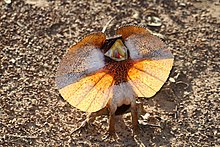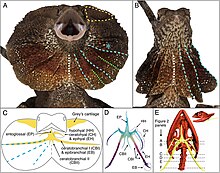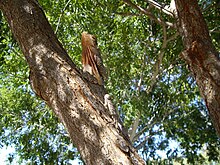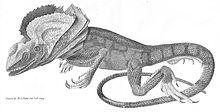Frilled lizard
| Frilled lizard Temporal range: Pleistocene - Recent[1]
| |
|---|---|

| |
| Scientific classification | |
| Domain: | Eukaryota |
| Kingdom: | Animalia |
| Phylum: | Chordata |
| Class: | Reptilia |
| Order: | Squamata |
| Suborder: | Iguania |
| Family: | Agamidae |
| Subfamily: | Amphibolurinae |
| Genus: | Chlamydosaurus Gray, 1825 |
| Species: | C. kingii
|
| Binomial name | |
| Chlamydosaurus kingii Gray, 1825
| |

| |
| Distribution of Chlamydosaurus kingii | |
The frilled lizard (Chlamydosaurus kingii), also known commonly as the frill-necked lizard, is a species of lizard in the family Agamidae. It is endemic to northern Australia and southern New Guinea. This species is the only member of the genus Chlamydosaurus.
Its common names come from the large frill around its neck, which usually stays folded against the lizard's body. C. kingii is largely arboreal, spending the majority of its time in the trees. Its diet consists mainly of insects and small vertebrates. Frilled lizards, or 'frillies' as some call them, will occasionally eat plants as well, although this behaviour is uncommon. It is a relatively large lizard, averaging 85 cm (2.79 ft) in total length (including tail) and is kept as an exotic pet.
Taxonomy
British zoologist John Edward Gray described the frilled lizard in 1825 as Clamydosaurus kingii. He used a specimen collected by botanist, Allan Cunningham at Careening Bay, off northwestern Australia, while part of an expedition conducted by Captain Phillip Parker King from HMS Mermaid.[3][4] The generic name, Chlamydosaurus, is derived from the Ancient Greek chlamydo (χλαμύς), meaning "cloaked" or "mantled", and Latin saurus (sauros), meaning "lizard".[5] The specific name, kingii, is a Latinised form of King's last name.[6] It is the only species classified in its genus.[7]
A genetic analysis of the species across its range using mitochondrial DNA revealed three lineages of recent divergence demarkated by the Ord River and Carpentarian Gap. One lineage ranged across Queensland and southern New Guinea and was sister to one that ranged from western Queensland to the Ord River. The ancestor of these two split from a lineage that populates the Kimberley.[8]
The following cladogram is based on Pyron and colleges (2013).[9]
|
| |||||||
Description
The frilled lizard grows to around 85 cm (33 in), and reaches a weight of 870 g (31 oz) for males and 400 g (14 oz) for females. It is relatively robust and long-legged, and its tail makes most of its body length.[10][7] The corners of its eyes are pointed, while the rounded nostrils face away from each other and angled downwards. It has long teeth in the front adapted for puncturing, while further back they are smaller with a cutting surface. Frilled lizards have sharp claws which allow them to climb trees.[11] Most of the lizard's scales are rough. From the backbone to the sides, the scales alternate in size between small and large.[7]

The distinctive frill is a flap of skin that extends from the head and neck and contains several folded ridges. The frill is laterally symmetrical; the right and left sides are attached at the bottom, while "Grey’s cartilages" connect the top ends to each side of the head near the ear openings.[12] When fully extended, the frill is disc-shaped and can reach reach 30 cm (12 in) across, and covers the neck and shoulders when folded.[10][12] It is proportionally around the same size in both sexes.[8] The frill is supported by rod-like hyoid bones, and is spread out by movements of these bones, the lower jaw and the Grey’s cartilages.[12] This structure mainly functions in communication between individuals and as a threat display to predators. It can also act as camouflage when folded, but this is unlikely to have been a consequence of selection pressure. There is no evidence for other suggested functions, such as food storage, gliding, sound amplification and temperature regulation.[13]
Frilled lizards vary between gray, brown, orangish-brown and black dorsally with the underside being paler white or yellow. Males may have black belly but a lighter chest. The underside and lateral sides are sprinkled with dark brown markings that may merge to create bands on the tail.[7] The frill display a gradient of colours from west to east in northern Australia; the westernmost populations have mainly red frills, transitioning to orange, yellow and finally white at the easternmost end. Colouration is mainly created by carotenoids and pteridine pigments; lizards with red and orange frills have more carotenoids than yellow and white frills, the latter two also lacking pteridines.[8] Among western lizards, the amount of red or orange colouring on the frill can signal dominance in males.[14]
Distribution and habitat

The frilled lizard is found mainly in the northern regions of Australia and southern New Guinea.[15] The lizard on rare occasions is found in the lower desert regions of Australia[16] but primarily inhabits humid climates such as those in the tropical savannah woodlands.[17]
It tends to be an arboreal lizard, meaning it spends a majority of its time in the trees.[17] The lizard ventures to the floor only in search of food, or to engage in territorial conflicts.[18] The arboreal habitat may be a product of the lizard's diet, which consists mainly of small arthropods and vertebrates (usually smaller lizards).[18] However, the trees are most importantly used for camouflage.[19]
Diet

Like many lizards, frilled lizards are carnivores, feeding on cicadas, beetles, ants, termites, and small mammals (such as mice and rats).[20][21][22] They especially favour butterflies, moths and their larvae.[23] Though insects are their primary source of food, they also consume spiders and occasionally other lizards.[24] Like most members of the agamids (dragons), frilled lizards employ an ambush method of hunting, lying in wait for their prey.[25] When the lizards eat, they eat in abundance; these binge periods usually occur during the wet season, when they ingest hundreds to thousands of alate (flying) ants or termites.[25]
Thermoregulation
The frilled lizard is ectothermic and maintains its body temperature by basking briefly to achieve an average of 2–3 °C (3.6–5.4 °F) above the surrounding temperature.[26] Weather conditions, including sunlight, are the main factors regulating the lizards' temperature. This basking period usually occurs in the morning to early afternoon to ensure maximum exposure to sunlight. However, the lizard's final internal temperature depends mainly on the ambient temperature of the surrounding environment. The lizard's frill was once thought to aid in thermoregulation, but this has been found to be without merit.[13][27]
Reproduction

Frilled lizards breed in the early wet season from September to October.[13] Adult males fight for mates, displaying their frills and biting each other. One to two clutches of 6–25 eggs are laid from early to mid-wet season from November to February.[13] The eggs are laid in a nest 5–20 cm (2.0–7.9 in) below ground, and usually in sunny areas. Incubation takes two to three months.[18] Gender is partly temperature determined, with extreme temperatures producing exclusively females, and intermediate temperatures (29–35 °C, or 84–95 °F) producing equal numbers of males and females. Their eggs are soft-shelled.[25]
Predators
The species' main predators are eagles, owls, snakes, dingoes, quolls, and larger lizards such as goannas.[28]
In culture
In the Jawoyn language of the Katherine area, it is known as leliyn.[29] A frilled lizard was featured on the reverse of the Australian 2-cent coin until 1991.[30] A frilled lizard named "Lizzie" was the mascot for the 2000 Summer Paralympic Games.[27] An anthropomorphic version of Lizzie reappeared as the mascot for the Australian team of the 2020 Summer Paralympic Games. The lizard features on the emblem of the Northern Australian regiment NORFORCE.[31]
Because of its unique appearance and behavior, the creature has often been used in film and television. A frilled lizard named "Frank" appeared in the 1990 Disney animated film The Rescuers Down Under.[32] In Steven Spielberg's 1993 film Jurassic Park, the dinosaur Dilophosaurus was portrayed with a similar looking neck frill that raised when attacking,[33] and generated an increase in demand for frilled lizards as pets.[34] It gained notoriety in Japan after featuring prominently in a 1984 commercial for the Mitsubishi Mirage.[35]
References
- ^ "Fossilworks: Agamidae".
- ^ O'Shea, M.; Allison, A.; Tallowin, O.; Wilson, S.; Melville, J. (2017). "Chlamydosaurus kingii". IUCN Red List of Threatened Species. 2017: e.T170384A21644690. doi:10.2305/IUCN.UK.2017-3.RLTS.T170384A21644690.en. Retrieved 19 November 2021.
- ^ Olsen, Penny (2010). Upside Down World: Early European Impressions of Australia's Curious Animals. National Library of Australia. p. 196. ISBN 9780642277060.
- ^ Kent, William Saville (1897). The naturalist in Australia. Chapman & Hall, limited. pp. 70–73.
- ^ Guyot, Arnold; Barnard, Frederick Augustus Porter; Johnson, A. J.; et al. (1890). Johnson's Univeral Cyclopædia A Scientific and Popular Treasury of Useful Knowledge · Volume 2. p. 64. ISBN 978-1013188343.
- ^ Beolens, Bo; Watkins, Michael; Grayson, Michael (2011). The Eponym Dictionary of Reptiles. Johns Hopkins University Press. p. 141. ISBN 978-1-4214-0135-5.
- ^ a b c d Cogger, Harold G. (2014). Reptiles & Amphibians of Australia (7th ed.). CSIRO publishing. pp. 700–701. ISBN 9780643100350.
- ^ a b c Pepper, Mitzy; Hamilton, David G.; Merkling, Thomas; Svedin, Nina; Cser, Bori; Catullo, Renee A.; Pryke, Sarah R.; Keogh, J. Scott (2017). "Phylogeographic structure across one of the largest intact tropical savannahs: Molecular and morphological analysis of Australia's iconic frilled lizard Chlamydosaurus kingii" (PDF). Molecular Phylogenetics and Evolution. 106: 217–227. doi:10.1016/j.ympev.2016.09.002. PMID 27664346.
- ^ Pyron, R. A.; Burbrink, F. T.; Wiens, J. J. (2019). "A phylogeny and revised classification of Squamata, including 4161 species of lizards and snakes". BMC Evolutionary Biology. 13 (1): 93. doi:10.1186/1471-2148-13-93.
{{cite journal}}: CS1 maint: unflagged free DOI (link) - ^ a b Savage, Melissa. "Chlamydosaurus kingii". Animal Diversity Web. Retrieved 2012-09-21.
- ^ Hammond, Paula (2010). The Atlas of the World's Most Dangerous Animals: Mapping Nature's Born Killers. Marshall Cavendish. pp. 86–87. ISBN 9780761478706.
- ^ a b c Montandon, S. A.; Fofonjka, A; Milinkovitch, M. C. (2019). "Elastic instability during branchial ectoderm development causes folding of the Chlamydosaurus erectile frill". eLife. 8: e44455. doi:10.7554/eLife.44455.
{{cite journal}}: CS1 maint: unflagged free DOI (link) - ^ a b c d Shine, Richard (1 May 1990). "Function and evolution of the frill of the frillneck lizard, Chlamydosaurus kingii (Sauria: Agamidae)". Biological Journal of the Linnean Society. 40 (1): 11–20. doi:10.1111/j.1095-8312.1990.tb00531.x.
- ^ Hamilton, D.G., Martin, J. W., and Pryke, S.R. (September 2013). "Fiery frills: carotenoid-based coloration predicts contest success in frillneck lizards". Behavioral Ecology. 24 (5): 1138–1149. doi:10.1093/beheco/art041.
{{cite journal}}: CS1 maint: multiple names: authors list (link) - ^ Grzimek, Bernhard; Olendorf, Donna (2003). Grzimek's Animal Life Encyclopedia: Reptiles. Gale. p. 216. ISBN 978-0-7876-5783-3.
- ^ Wagner, Frederic H. (1980). Wildlife of the Deserts. H. N. Abrams. p. 188. ISBN 978-0-8109-1764-4.
- ^ a b Savage, Melissa (2001). "Animal Diversity Web: Chlamydosaurus kingii". University of Michigan Museum of Zoology. Retrieved 17 November 2009.
- ^ a b c Greer, Allen E. (1989). The biology and evolution of Australian lizards. Surrey Beatty. p. 24. ISBN 978-0-949324-21-4.
- ^ Shine, R and Lambeck, R (1989). Ecology of Frillneck Lizards, Chlamydosaurus-Kingii (Agamidae), in Tropical Australia. Australian Wildlife Research 16, 491–500.
- ^ "Frilled lizard, frill-neck lizard, King's lizard". Archived from the original on 2009-08-09. Retrieved 2009-11-17.
- ^ "Frilled-Neck Lizard". 24 September 2020.
- ^ "Frilled Lizard".
- ^ "Frill-Necked Lizard". Retrieved 2009-11-19.
- ^ Bradtke, Birgit. "The Australian Frilled Lizard". Retrieved 2009-11-17.
- ^ a b c Shine, Richard; Robert Lambeck (1989). "Ecology of Frillneck Lizards in Tropical Australia" (PDF). Australian Wildlife. 16: 491–500. doi:10.1071/WR9890491. Retrieved 2009-11-20. [dead link]
- ^ Wilson, Steve (10 October 2012). Australian Lizards: A Natural History. Csiro Publishing. p. 85. ISBN 978-0-643-10642-0.
- ^ a b "Frilled Lizard". Burke's Backyard. CTC Productions. 2000. Retrieved 10 December 2009.
- ^ "Animal Fact Sheets Frilled Lizard (Chlamydosaurus kingii)". ARAZPA. ARAZPA. 2006. Archived from the original on 2009-10-30. Retrieved 2010-01-06.
- ^ Jawoyn Association (2015). "Jawoyn is the language of the Katherine area, and of country north and east of Katherine". Katherine, Northern Territory: Jawoyn Association. Retrieved 1 June 2015.
- ^ Bruce, Colin R; Michael, Thomas (11 June 2007). 2008 Standard Catalog of World Coins 1901-2000. Iola, Wisconsin: F+W Media, Inc. p. 119. ISBN 978-0-89689-500-3.
- ^ "Unit History". Archived from the original on 2011-09-27.
- ^ Bancroft, Tony (2013). Directing for Animation: Everything You Didn't Learn in Art School. CRC Press. p. 5. ISBN 978-1-136-12654-3.
- ^ Pianka, Eric R.; Vitt, Laurie J. (1 May 2006). Lizards: Windows to the Evolution of Diversity. University of California Press. pp. 145, 269. ISBN 978-0-520-24847-2.
- ^ Christy, Bryan (2008). The Lizard King: The True Crimes and Passions of the World's Greatest Reptile Smugglers. New York: Twelve. pp. 256. ISBN 978-0-446-58095-3.
- ^ "1984年に日本上陸「エリマキトカゲ」 大ブームで便乗商品が氾濫、あなたは持ってた?(アーバン ライフ メトロ) - Yahoo!ニュース". Archived from the original on 2020-11-05.
Further reading
- Bedford GS. (1995). "Anti-predator tactics from the Frilled Neck Lizard Chlamydosaurus kingii ". Journal of the Victorian Herpetological Society 6 (3): 120-130.
- Harlow PS, Shine R. (1998). "Temperature dependent sex-determination in the frillneck lizard Chlamydosaurus kingii (Agamidae)". Herpetologica 55 (2): 205-212.
- Shine R, Lambeck R. (1989). "Ecology of frillneck lizards, Chlamydosaurus kingii (Agamidae) in tropical Australia". Australian Wildlife Research 16: 491-500.

